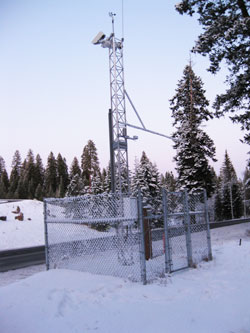Best Practices for Road Weather Management
Idaho TD Winter Maintenance Performance System
The Idaho Transportation Department (ITD) is in the final stages of developing its Winter Maintenance Performance Measures System which will include 87 Road Weather Information System (RWIS) sites. At the time of publication, sixty sites are operational. Statewide implementation of the system began in 2011. Currently, ITD is identifying the performance levels of its winter maintenance operations in all districts. Depending on the results of this effort, some existing maintenance practices in various locations may be altered to increase operational efficiencies. ITD anticipates there will be several seasons of continual improvements in the RWIS network while allowing time for appropriate operational adjustments to be made.
System Components: Each RWIS site (see Figure ID-1 for an illustration), in addition to the atmospheric sensors, typically has two road surface sensors: one to measure the road’s grip coefficient (DSC111); and one to measure road surface temperatures (DST111).
Additionally, ITD is developing a system to automatically track maintenance data. Similar to many states, ITD is moving toward Automatic Vehicle Location (AVL) and Mobile Data Collection (MDC). Information on salt usage, anti-skid, liquid quantity usage, application rates and plow down/up time is currently manually recorded and entered into a database.
ITD plans on automatically collecting this information from its winter maintenance fleet, and integrating it into the state’s Maintenance Management System (MMS) database—thereby eliminating the human generated reports that were time consuming and error-prone.
Having such an automated system will also allow ITD to integrate with the automated RWIS performance measure system for expedited data fusion, allowing rapid review, critique and operational adjustments to minimize deviation from the new Best Management Practices (BMP).
System Operations: In responding to winter storms, the treatment objective is to minimize the “ice-up” time. ITD has developed a performance measure Index. Specifically, the Performance Index is a measure of ice duration per unit of storm severity. Storm severity is modeled using an empirical formula that utilizes wind speed, surface precipitation accumulation, and surface temperature. Ice duration is defined as the amount of time grip falls below 0.6. Data collected from the RWIS stations is used to determine various parameters in the Performance Index formula. This metric allows for accurate evaluation of different treatment strategies and maintenance operations.
Transportation Outcome(s): The primary benefit will be improved safety and mobility of the traveling public. Maintenance crews will now have the ability to evaluate treatment selections along with timing of applications and rates. This will lead to continual reevaluation of current BMPs to continue the trend of reducing ice-up time. The new BMPs are anticipated to reduce time and materials for storm event clean up and better utilize resources. Anticipated cost savings from new BMPs will allow ITD to expand the RWIS network allowing other areas to reap the rewards of the RWIS data and expand the system to additional locations.
Implementation Issues: Receptiveness to the system across ITD was rather low upon the first year of statewide implementation. As the winter season progressed and the RWIS locations became more reliable and acceptable, the performance measures gained momentum. Funding was an issue initially, but with the acceptance of the system came a reevaluation of intelligent transportation system (ITS) projects; funding was redirected into the RWIS Performance Measurement and Reporting (PMR) upgrades. All 87 RWIS stations are anticipated to be PMR ready by fall of 2012. New sites are being discussed and programmed by the districts to continue the expansion process. The districts have submitted request for a complete statewide build out of a total of 140 PMR sites.
Contact(s):
- Dennis Jensen, Idaho Transportation Department—Mobility Services-Winter Maintenance Coordinator, Office 208-334-8472, Cell 208-901-1100.
- Ed Bala, Idaho Transportation Department—District 5 Engineer.
Keywords: performance measure, ice-up time, grip coefficient, surface temperature, and best maintenance practices.
previous | next